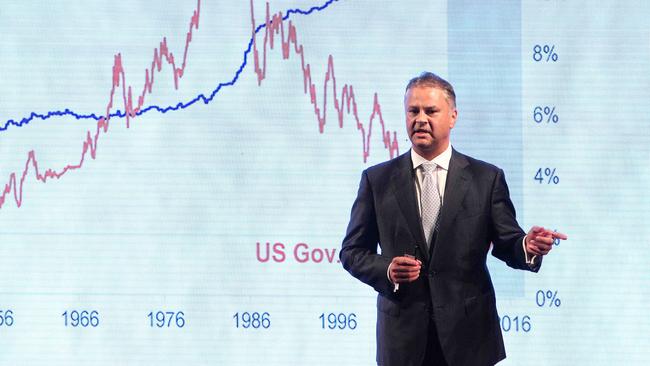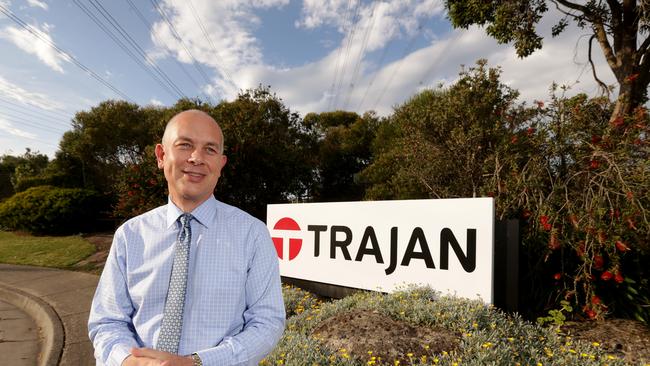
Rapid moves in financial markets will always create some concerns, and this action in the fixed income market burnt some traders who had bet against aggressive RBA moves after Philip Lowe’s team went hard with $5bn in purchases.
The aim is to increase prices which in turn sends yields down.
Along the way the talk is some hedge funds were caught badly on the wrong side of the trade.
The RBA’s purchases concentrated a week’s worth of trade into a single day and by all reports it was back in the market on Friday with $2bn worth of purchases.
The Fed is also buying aggressively but the market was disappointed its chief Jerome Powell didn’t spell out any change in strategy to counter the rally in bond prices in the US and around the world.
In reality what the RBA does in Australia is important but globally it’s the Fed that counts.
The moves in the US are being fuelled by President Biden’s $US1.9 trillion ($2.45 trillion) COVID stimulus plan, which is massively increasing bond supply, and other things being equal pushes prices down and yields higher.
Still the message from UniSuper’s chief investment officer John Pearce is not to worry about the bond market sell-off because it’s simply a replay of past history when stocks rally and the bond market sleeps only to realise later what is happening.

He is right but that doesn’t mean there isn’t damage along the way.
Australian stock prices increased over 50 per cent from March lows last year to their February highs on the belief that the V-shaped post-COVID bounce would continue.
Last month’s earnings season validated the move until the bond market’s delayed reaction created concern that maybe inflation will come roaring back.
The prevailing wisdom says it won’t and the market is wrong.
Still, since the middle of last month the Australian market is down 3.3 per cent, the tech-heavy Nasdaq is down by 9.7 per cent and Australian IT stars are down as much as 19 per cent,
The carnage was caused in the move from high growth hopes to more sustainable value with Appen down 28 per cent, Altium down 16 per cent, Afterpay off 15 per cent, Bravura down 14 per cent and with Xero and WiseTech off by 13 per cent.
On Friday US bonds sold off some more when US Fed chief Jerome Powell maintained his dovish line but the market was looking for more, hoping he would talk up Fed action to boost bond prices.
Instead he repeated the line that the US was a long way from the Fed’s goals about maximising employment with inflation over 2 per cent.
RBA chief Lowe has been more prepared to back his statements, talking up market action such as promises to buy more bonds.
In the wake of Powell’s caution all eyes locally will be on Lowe when he addresses an industry conference in Australia on Wednesday.
Bond yields rise when prices fall.
In the US 10-year bond yields rose to 1.57 per cent, with Australian 10-year yields rising to 1.84 per cent.
Pearce says that even with US 10-year yields at up to 2.5 per cent the free cash yield on stocks is 3.5 per cent so there is plenty of upside for equities.
The local stockmarket bottomed last March at 4546 points when COVID first hit and has rallied since by 52 per cent to a high of 6917 in the middle of last month.
That massive rise, based on hopes of a V-shaped recovery in the economy, was confirmed by a strong corporate earnings season.
It came in two spurts from the March 2020 lows to as high as 6200 points, a 38 per cent increase to last June, then a period of consolidation before a 16 per cent increase to 6917 in February.
The point being stocks took off while the bond market was looking the other way, and now it is playing catch up.
This is not unusual when you consider inflation is a lagging economic indicator and that is what sets the markers for bond trading.
The advice to retail investors then is to be aware but not alarmed.
Serious science
Melbourne-based Stephen Tomisich has shown it is possible to establish a manufacturing company in Australia and to collaborate with universities through his company Trajan Scientific and Medical.
The company, which is approaching $100m in revenue, has engaged Ernst & Young to advise on the best way to finance the next growth leg with a stockmarket float the obvious option.

Tomisich and his wife Angela set up the company a decade ago to create a vehicle for science to benefit people.
This is done through proprietary engineered components and analytical technologies.
Angela comes to the table with a background in pathology and Stephen from a string of jobs for global pharmaceutical and medical companies.
Through a series of six acquisitions and its own innovations it now employs 442 people around the world with three manufacturing plants in the US, one in Malaysia and another in Melbourne.
It has a team of 80 scientists and engineers and spends around 10 per cent of its revenues on research and development.
Some 60 per cent of revenues are from chromatography, which separates components from a mixture to allow further study, and another 15 per cent from automation.
Automation includes robotic equipment for labs, with Trajan producing the underlying technology
The US accounts for 40 per cent of revenues, Europe 30 per cent, Asia 20 per cent and Australia just 10 per cent.
The company is profitable, and while backed by HSBC, it is self-funding on new developments with any float aimed at helping to finance the next growth leg.
The founders will retain a majority stake.
One product which has attracted interest is the hemaPEN which allows patients to prick their thumb. Blood drops are collected in a pen which is sent to labs for processing. It is a lot less invasive then traditional methods.
This also allows collection of blood samples of athletes before, during and after exercise.
This and other processes all add up to a data-generating business which in time will be the major revenue source.




The bondcano has created some concern for the stockmarket but the bottom line is there is value to be found in Australian stocks, which are selling on a dividend yield of 3.5 per cent against 1.84 per cent for the 10-year bond yield.